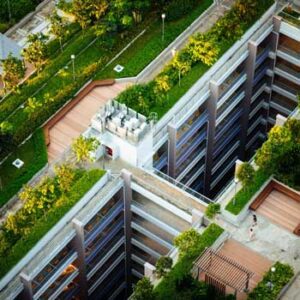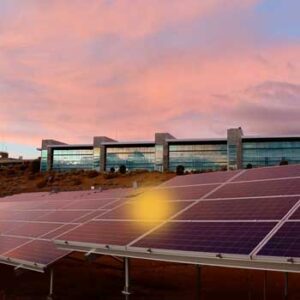What is green construction?
No, it doesn’t mean that you paint a new building the color green. Calling a building “green” actually says more about how it’s built than how it looks.
Green construction refers to the philosophy and processes that makes the creation and usage of the built environment as friendly to the natural environment as possible. From the design stage to assembly to the functionality of the structure upon completion, green construction focuses on reducing negative impacts to the planet and even adding some positive benefits.
Construction is a necessary part of modern life – humans need homes to live in, schools to learn in, businesses to work at and roads to drive on. Any construction will have some inevitable impact on the environment. With a growing global emphasis on sustainability, it is the responsibility of the construction industry to take steps to both minimize their own footprint in raising a new building as well as designing that building to operate in a sustainable way for many years to come.
Green construction is the answer to that call and is a rapidly growing aspect of the industry. Here are some of the new processes and innovations that are part of the green construction movement.
The first step in construction is design. Architects and engineers work to create blueprints and plans for the new building and the property it stands on. This is where the layout of the building, the outward appearance of the building, and all the systems and components that make up the structure are sketched out and prepared to be put into action.
This design stage is one of the most important for green construction because this is where decisions are made about what type of features should be included in the new project and the sustainable steps to take to execute the build. Everything from the electrical and water systems inside to the landscaping outside can have a hand in the green status of the building, and the designers are the ones who create the instructions for the builders.
Environmental architecture and environmental design are actually the top “green degrees” offered by colleges and universities nationwide. Today’s students hold the environment as one of their top concerns for the future, so many are pursuing careers in sustainability. As more designers receive training in green architecture, that influence will continue to fuel the steps toward a greener construction industry.

One of the aspects of construction that has the biggest negative impact on the environment is the processing of building materials. Creating the wood, steel, concrete and other materials used in construction can cause deforestation, pollution, carbon emissions and other harmful effects.
To minimize this impact, green construction can look at the materials they use and how they are sourced, processed and disposed of to make more environmentally friendly choices. A building could be built with more eco-friendly natural materials instead of heavily processed or potentially toxic ones. Another option is to use higher quality materials to reduce the need for frequent repairs or replacements.
Construction teams can also recycle materials that have been saved from demolished buildings or scraped as unused components from other projects. Many metals are durable and can be reused or recast for new buildings, reducing the heavy impact of extracting more raw materials from the earth. Concrete and other materials can also be recycled.
The way a structure gets physically built can also have an influence on its environmental impact.
Modular construction is one building method that is showing promising results in going greener. Rather than a structure being fully built on-site, modular construction involves using larger components that have been prefabricated or made in an off-site facility. Prefabrication allows for a more controlled environment to build in, which can result in less material waste, reduced energy consumption and higher quality builds.
Prefabricated pieces such as wall segments are transported to the project site, where they are assembled. With this system, modular construction can also speed up the on-site work of the project, reducing potential disruption to the community.
Modular construction and prefabrication are among the new ways of thinking about building that can drive the industry greener.
Green buildings often turn to cleaner alternative energy options as a means to power (or partially power) their operations.
For most buildings, an easy way to do this is through solar panels. Many modern offices and homes have solar panels installed on their roofs. These panels can collect the sunlight exposed to the top of the building each day and help create electricity. Buildings with more surrounding property might have larger solar arrays set up on the ground adjacent to the buildings.
Even a few small solar panels can help to create greener energy and reduce the use of fossil fuels and their emissions.

Modern buildings have lights, HVAC units, running water and other amenities that require power and resources. For many of these, there are eco-friendly options that improve efficiency and reduce energy usage and costs compared to other options.
One example of this is windows. Thin windows that aren’t well-sealed can cause excessive heat transfer, meaning that HVAC systems need to expend more energy to maintain temperature control. Installing high-quality double-paned windows with a strong seal can reduce the unwanted heat transfer and energy usage. Similar effects can be had by upgrading doors and insulation.
Other examples of environmentally friendly fixtures include:
As green construction becomes the standard in the industry, celebrating the progress and achievements on the path to sustainability can be a big part of continuing to drive those steps.
Awards, honors and unique certifications are all used to acknowledge accomplishments in green construction by contractors, industry leaders and the buildings themselves. The most well-known of these is LEED (Leadership in Energy and Environmental Design), a green rating and certification system administered by the U.S. Green Building Council. By reaching various eco-friendly benchmarks, projects can be awarded LEED Certified, Silver, Gold or Platinum status.
These certifications become a badge of honor for a building and the teams who built it. Companies are striving to reach the highest levels they can through pushing the boundaries and innovating in new ways.
Construction is one of the biggest sectors of the economy, and demand for new and renovated buildings and infrastructure will keep the industry busy for years to come. With such an important role in society, construction has a responsibility to be a leader in implementing sustainable practices and limiting the impact on the environment. As the long-term effects of our actions become a greater focus, green construction will continue to grow and become the new standard.